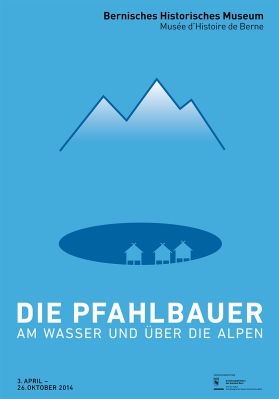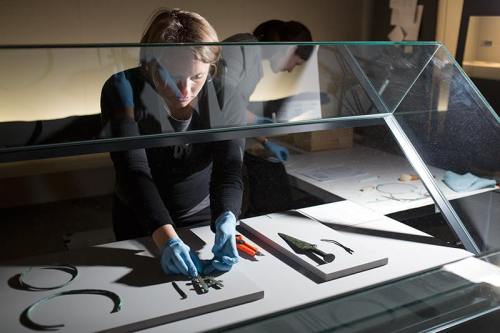The first European Neolithic site I dug was in the south of the Netherlands. All we found were post holes, colourful traces in the yellow sand. We found a handful of pottery shards and a few flint tools, and not very nice ones either, as far as I remember. We were most excited about the remains of traces of old top soils from various periods, or at least I was. It was all very different from the Pre-Pottery Neolithic sites in Jordan I had worked on, where we found huge quantities of finds as well as standing walls.
Yesterday was the official opening of the new exhibition at the Bernisches Historisches Museum. A new temporary exhibition on the Pfahlbauer – Am Wasser und über die Alpen (The Pile Dwellers – on the water and over the alps). And it’s a jaw dropper! I remember the reverence in the voice of the lecturer – I think it was Prof. G. Barker – of our introductory course at University of Leicester. There was obviously something very special about these Swiss Lake side villages. And indeed, you do not have to work in Swiss archaeology long to realise there is something extraordinary about these sites.

Visual zur Wechselausstellung «Die Pfahlbauer – Am Wasser und über die Alpen»
© Bernet & Schönenberger, Gestaltung und Typografie, Zürich
In the middle of the 19th Century Switzerland made a new start, with a new constitution and a new political organisation. Around the same time the first Lake side villages were discovered when, during a dry summer, water levels in lakes across the country dropped dramatically. The inhabitants and builders of these Pfahlbauten, or pile dwellings, have since played a remarkable symbolic role in the building and maintaining of the Swiss national identity. The exhibition, however, only goes into this very briefly and mostly pictorial.
For me as an archaeologist one of the most exciting aspects of these Neolithic and Bronze Age sites, which date between 4300 – 800 BC, is the fine dating they allow. Sometimes dendrochronology, or tree ring dating, allows us to determine the exact year in which a certain village was build ca. 5300 years ago and when and how it grew and buildings were added. Or we know how many years a village was inhabited, when a village was given up and its inhabitants moved along the lake edge to a new location. This is something most other prehistorians working elsewhere in the world can only dream of. Being able to date the buildings one can also date the finds that are found in them. Thus over the past 160 odd years a very fine chronology of cultures and artefacts has been established.

«Die Pfahlbauer – Am Wasser und über die Alpen»
© Bernisches Einrichten Pfahlbauobjekte. Historisches Museum, Bern. Foto Christine Moor
Perhaps the scientific potential and the influence of new scientific methods, such as isotopic analyses and aDNA studies and the new directions dendrochronology is moving into, do not get the amount and depth of attention they deserve. However, for the average visitor this will probably be a negligible omission. And besides, the width and variety of finds on show do more than make up for it.
Because, yes, that is what makes this exhibit: the objects. The museum has a very rich collection of finds dating from the Neolithic and the Bronze Age in the Canton of Berne, also because it was responsible for archaeological excavations until 1970 when the Archaeological Service of the Canton Berne was founded. And now it is these two institutes that collaborated on the exhibition. Together with many objects from other, mostly Swiss, collections, the curators have collected a stunning array of finds. Not only can visitors allow themselves to be dazzled by the oldest golden cup (2400 BC, Eschenz), worldwide apparently, but there is also the oldest European bread and wheel (3700 BC) and a Neolithic door and and and and. Now, I am not too impressed by the oldest this and that, but it does show the richness of the assemblage on show.
The finds are grouped, not chronologically but by their role in various facets of people’s lives, such as craft, death, religion and ritual and transport and travel. Five rooms, each dominated by huge colourful panels showing scenes of different aspects of daily life (someone told me they are between 8 – 11 m long, allowing you to almost step into these past worlds). They all feature objects on show as they may have been used in the Neolithic or Bronze Age. We see a shore scene: children playing on a shore, gnawing a fish, there are pigs, dug-outs, dogs, fishing nets. We see a woman from the Valais, dressed in the typical clothes of the valley during the Early Bronze Age. She has crossed the Alps to come and sell and buy goods near Spiez in the Bernese Oberland. We see two men and a child making bronze axes and pendants. We see a dug-out canoe on the Lake of Biel during a winter ceremony. We see the lady buried at Spiez-Einigen in life and the `Prince of Renzenbühl´. But we see the actual objects – needles, bronze headdresses, arm rings – they were buried with as well. And the pendants that were made and the dug-out. Almost 500 objects in all! Striking are also the `simpler´ finds. Who would not marvel at finding a charred 5500 year old bread, or a long length of string that somebody carefully wound up into a ball thousands of years ago, or a hat made of reeds, Neolithic stone axes, but for once still in their wooden hafts! Or at a 20 cm long exquisitely made flint daggers, also with their original handles of wood and leather? Or at an over five millennia old wooden door and wheels?

Pfeile, Bogen und Bogenfutteral, welche auf dem Schnidejoch (Berner Oberland) gefunden worden sind. Diese Funde sind in der Ausstellung «Die Pfahlbauer – Am Wasser und über die Alpen» erstmals öffentlich zu sehen.
© Archäologischer Dienst des Kantons Bern, Bern. Foto: Badri Redha, Zeichnung: Max Stöckli
We also see, for the first time presented to the public, the finds from the Schnidejoch, presented in front of a fantastic panorama. They are amazing finds. No bodily remains were ever found, like Ötzi’s on the Tissenjoch. Still, the man’s (as it is presumed to have been a man) 6500 year old equipment and those of others who crossed the 2700 m high pass during the following millennia, are stunning! Parts of his trousers, shoes and cape are preserved, as well as, amongst other items, his bow, arrows. A sewn wooden container and a cup date to the Early Bronze Age. (Sadly, we are still waiting for the complete scientific publication of the finds!) Like today, the Alps were part of people’s lives in central Europe. Contact and trade between people living in and on either side of them was frequent. The Alps were of great economical importance (transhumance, resource extraction, hunting, gathering).
Together with the finds from the lakes, the exhibition lets the alpine finds speak for themselves. They are there to be marvelled at; their beauty, the ingenuity and quality of the craftsmanship that went into making them. But also how they enable archaeologists to interpret the past in such detail becomes clear. And the combination of the finds showing such a wide scope of the daily lives of past people and the interpretative scenic panels on which the possible use of the objects is illustrated in an unobtrusive way make the objects come to life for the general public as well.
Otherwise, the information given by the curators are quite sparse. The objects and scenic panels stand alone to illustrate the current scientific interpretation of the Neolithic and Bronze age in Switzerland. There are a few small screens showing animations that explain some of the more scientific aspects of modern archaeological research and the texts are short and kept quite small. Sometimes there could have been a bit more information with the finds. What kind of wood was used for the construction of the door from Zürich-Opèra? To what part of the Late Stone Age does that pot date? You also have be rather observant to realise to which period a scene on these panels might refer. We are talking about a 2500 year long period after all and one which is actually exceptionally well dated at that.

Blick in den Themenraum «Handel und Verkehr» in der Ausstellung «Die Pfahlbauer – Am Wasser und über die Alpen»
© Bernisches Historisches Museum, Bern. Foto Christine Moor
The texts in the exhibition are all in three languages (DE, FR, EN). Their being so small makes them very unobtrusive, giving more prominence to the finds. But the small texts and the fact that so many cases are in the wall might be annoying when the exhibition is busy. Otherwise, the design is contemporary, dark and minimalist. Inside the exhibition is not interactive at all. This is compensated for outside, in the `museum park´. Here the Neolithic will come to live. Throughout the duration of the exhibition a Neolithic house will be built using prehistoric techniques and cereals and pulses will be grown and the grave finds from Thun-Renzenbühl will be replicated. The house will be based on those found on the shores of the Lake of Biel, at Sutz-Latrigen. A large educative program, esp. for children and school classes will accompany the exhibition.
In the Neue Museum Biel a pleasant and small temporary exhibition complements the Berner display, showing dug-out canoes and the way they were perceived through the ages, from the oldest Swiss dug-out, discovered at Moosseedorf in 2011 to those of the early 20th century. Here as well, you can see `prehistory happening´, as a dug-out is being made on site. It will be launched in the Lake of Biel may 18th 2014.
We can congratulate the makers of both exhibitions. And although, due to their differences in scale, they cannot be compared, there are many reasons to go and see both. For me the scope of the finds at the Bernisches Historisches Museum, the way the objects bring the daily lives of prehistoric people to life, as almost no other group of sites can, in combination with the amazing ice finds are truly something special.
I do wish, though, someone would come up with a decent explanation for why somebody 5000 years ago lost a trouser leg and a bit of shoe on top of a high alpine pass.
Neue Museum Biel – Pirogue Préhistoire de la navigation 29.03.2014 – 06.07.2014
Bernisches Historisches Museum – Die Pfahlbauer – Am Wasser und über die Alpen 3.04.2014 – 26.10.2014



Pingback: Historical fantasies or the inherent subjectivity of archaeology? Die Pfahlbauer in Bern. | hazelnut relations